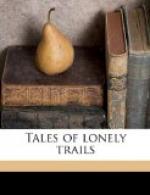Later that day, in an open grassy canyon, we came upon quite a large bird, near the size of a pigeon, which I thought appeared to be a species of jay or magpie. This bird had gray and black colors, a round head, and a stout bill. At first I thought it was crippled, as it hopped and fluttered about in the grass. I got down to catch it. Then I discovered it was only tame. I could approach to within a foot of reaching it. Once it perched upon a low snag, and peeped at me with little bright dark eyes, very friendly, as if he liked my company. I sat there within a few feet of him for quite a while. We resumed our ride. Crossing a fresh buck track caused us to dismount, and tie our horses. But that buck was too wary for us. We returned to camp as usual, empty handed as far as game was concerned.
I forgot to say anything to Haught or Doyle about the black and gray bird that had so interested me. Quite a coincidence was it then to see another such bird and that one right in camp. He appeared to be as tame as the other. He flew and hopped around camp in such a friendly manner that I placed a piece of meat in a conspicuous place for him. Not long was he in finding it. He alighted on it, and pecked and pulled at a great rate. Doyle claimed it was a Clark crow, named after one of the Lewis and Clark expedition. “It’s a rare bird,” said Doyle. “First one I’ve seen in thirty years.” As Doyle spent most of his time in the open this statement seemed rather remarkable.
We had frost on two mornings, temperature as low as twenty-six degrees, and then another change indicative of unsettled weather. It rained, and sleeted, and then snowed, but the ground was too wet to hold the snow.
The wilderness began all at once, as if by magic, to take on autumn colors. Then the forest became an enchanted region of white aspens, golden-green aspens, purple spruces, dark green pines, maples a blaze of vermilion, cerise, scarlet, magenta, rose—and slopes of dull red sumac. These were the beginning of Indian summer days, the melancholy days, with their color and silence and beauty and fragrance and mystery.
Hunting then became quite a dream for me, as if it called back to me dim mystic days in the woods of some past weird world. One afternoon Copple, R.C., and I went as far as the east side of Gentry Canyon and worked down. Copple found fresh deer and turkey sign. We tied our horses, and slipped back against the wind. R.C. took one side of a ridge, with Copple and me on the other, and we worked down toward where we had seen the sign. After half an hour of slow, stealthy glide through the forest we sat down at the edge of a park, expecting R.C. to come along soon. The white aspens were all bare, and oak leaves were rustling down. The wind lulled a while, then softly roared in the pines. All at once both of us heard a stick crack, and light steps of a walking deer on leaves. Copple whispered: “Get ready to shoot.” We waited, keen




